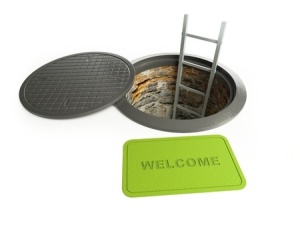I hope you find my writing and business tips and observations useful. My business and blog are dedicated to helping businesses communicate clearly and reach their potential.
Read, subscribe to my newsletter, enjoy!Tash
Production English
Last night I heard of production English for the first time and am quite fascinated with it.
New country, new language
When many people arrive in Australia, they learn English to be able to communicate with other people who live here. English classes teach them things like ‘hello, how are you?’, ‘can I please buy…?’ and ‘where is the library?’
And there’s nothing wrong with that.
I assume the same thing happens for most people who move to a country with a language different to their own.

How would you interpret this situation if you couldn’t read much English? Safety can be jeopardised if people can’t read or understand notices.
What about less generic language?
The challenge really starts when people need more specific language – the words and phrases you don’t get in beginner classes.
For instance, trying to follow a procedure or read instructions on machinery can be quite difficult if you only have basic English.
Especially once you consider grammar and similar words (that is, homonyms and other potentially confusing words that I define in Monday Meanings) can make it even harder to understand – just like pilots can have trouble if English is not their native tongue.
The story I heard last night was about a group of people who work well at their jobs but are sometimes limited or put at risk by the fact that they don’t have ‘production English’ to help them at work.
Obviously, ensuring that procedures and instructions are written as simply and clearly as possible is one aspect – and still a very important task.
Yet it is also critical to help such people learn relevant words in English. And there are programs in Melbourne now that are working on solving this issue, at least for some groups of immigrants.
Does your business have procedures or instructions that would be challenging for someone with only basic English?
* Image courtesy of 123RF
Making procedure manuals accessible
Looking back at what I’ve written in previous June, I came across a post from 2011 about making manuals less intimidatingand therefore simpler to use.
A manual or instruction guide is just a collection of procedures. If each procedure is written well, they are useful documents to have in any business.
Once people are used to having good procedures to follow, it is a simple step to make manuals accessible rather than intimidating and officious.
Manuals can be presented in many ways
Even to me, the word manual conjures up images of big heavy folders, covered in dust, and difficult to use.
There is no need for all your procedures to be kept in a heavy (or light!) folder. Make it more accessible with any or all of the following ideas:
- put individual procedures where they are used. So the procedure for how to use a piece of equipment is stuck on the wall near that piece of equipment or inside it’s case if the equipment is portable
- make the procedures available in soft copy in a series of folders – looking in an electronic folder is something most people are now used to while hyperlinks and search functions make it even easier to find the right procedure
- for procedures you do need to print out, put only related procedures in each folder so they can be stored where needed and handled with ease
- think about other ways to have all procedures (and perhaps your policies as well) together. Maybe a tablet or e-reader would be more useful in your situation – there is a search function, version control is easy and the collection is light to carry around and use
What creative ways can you think of for presenting procedures in your business?
Getting procedures used
If you have gone to the effort of creating some procedures, you want to have your team make use of them.
Let’s face it, many of us have tried putting together an Ikea unit before reading the instructions – often to use them later. But we don’t want that happening to the procedures we spend time on writing to benefit our businesses.
Here are four tips for encouraging use of your procedures:
- when presenting them (for instance, if emailing it out to your team), sell the benefits.
Would you respond better to ‘procedure you must use’ or ‘record sales data quickly’? - lay out each procedure clearly and neatly
if it looks easy to read and follow, people are much more likely to use procedures so use the basics of good procedures such as lists rather than paragraphs, decent size fonts and short instructions (‘hit submit’ not ‘use your mouse to click on the submit button’) - make the procedures easy to find
if you have a shared computer area (intranet or a shared folder somewhere) or a physical shelf or cupboard, put the procedures there so everyone can always access to most recent version. For specific equipment, keep the procedures nearby – I don’t want to have to visit the main office to use the machinery in the workshop. Then make sure procedures are named clearly so it’s easy to find the relevant procedure when it is needed. - keep procedures up to date
imagine following a procedure that has an old password or refers to an old version of software (especially a major change so steps have changed) – it’s very frustrating. Let people get frustrated with your procedures and they’re less likely to refer to it again. Most updates are quick but if it is a big change and will take time, note that on the existing procedure so at least people know to expect changes and that a new version is coming.
What makes you use any procedures you find helpful?
A manual by any other name…
It’s an officious sounding word for many people, and certainly a daunting prospect if you have to write or update the manual for your business. So much so, that people often avoid having a procedures or operations manual or just call it something less intimidating.
Which raises the first question – what is a manual?
Really it is just a collection of ideas and instructions to help operate something efficiently. It may be boring to read the manual that came with your new iPod, phone or TV but it is very handy when you can’t figure out how to set it up or use the advanced features.
Manuals range from a few pages long to hundreds and even thousands of pages long, depending on the purpose of the manual. Obviously the manual to run a multi-million dollar business will be longer than the manual for your home printer, but the concept is the same.
Here are a few tips to make the concept of a manual less intimidating in your business:
- call it something other than a manual if the name has negative associations for you – options include guidelines, procedures, rules, ‘helpful information’, policies and the ‘how to book’
- make sure to write it (or get it written) in simple terms so it’s easy to understand
- present it in an accessible way – a heavy folder stored on a high shelf will be ignored but a shared computer file on your intranet is much easier to use
- divide the manual into usable chunks – much better to have a long index than instructions that go for pages and cover many tasks
If you are starting a new manual from scratch, you have the advantage of making it friendly from the start, and preparing procedures and style guides doesn’t have to be frightening either!
Thinking about manuals you’ve had to use in the past, what were some of the big issues with them?
Repeat what works
“if it aint broke, don’t fix it” is an expression that really makes sense to me. I see no reason to spend time on something that is working when other things need my attention.
Yes, everything in business should get reviewed periodically to check for possible improvements. But reinventing the wheel each time you do something is just a waste of time in my mind.
For example, if your current marketing plans keep you a steady stream of clients that meets your work and profit requirements, then stick to it! Keep an eye on new avenues but don’t drop the past efforts to grab the latest trends like twitter and Facebook – those new things may not work with your audience for one thing, and it will take time for you to learn the most effective ways to use new ideas in your business.
I came across a sales page recently which talked about repeating simple procedures – I thought it made good sense and reminded me of the above quotation. The writer made the point that a surgeon follows the same steps every time a certain operation is performed, a javelin thrower throws the same way every time and a bank uses the same forms and processes for every loan they approve.
Having a simple procedure makes it easier to complete a task, but more importantly, it ensures you get the best results in the most efficient way every time – even if different people carry out that same process.
For things that are working well in your business, do you have a simple procedure to follow? And that someone else could follow for you? Once you write out such procedures you can save time to work on the things that are broken – and prepare procedures in those areas to find an effective way to do those tasks.
It’s not quite the same as leave good things alone, but having a written procedure for things that work allows for almost-mindless repetition so things keep running along smoothly.
Having procedures
If you have worked in the corporate world, you know that big businesses have procedure manuals and policies for how things are to be done. They may vary in effectiveness, but they have been thought out and written.
Maybe you consider this something that only belongs to big business, but small and medium businesses should also have some procedures written out.
A small business will have fewer procedures, may not call it a manual and may be more flexible in their approach, but the concept is the same.
Why have procedures?
Many small business owners, especially sole traders, know how to run their business so don’t see any reason to write down their procedures. But what happens when the owner isn’t the one trying to carry out a particular task one day?
By having procedures written down, someone else is able do the job with minimal disruption to clients and the overall business.
Here are some the main reasons to have procedures written down for your business:
- Someone is able to fill in for you if you are sick or go on holidays
- Less time is required to train new staff
- You have a system to sell, either as a franchise or if you sell the entire business
- There are less likely to be human errors because someone forgets a key step
- Clients receive consistent answers and service
For some tips on how to start getting some procedures for your business, read my article on business procedures. For a full run on why procedures are useful and how to use them as well as how to prepare procedures for your business, my preparing procedures eBook is jam-packed with information and tips.
Crucial planning ahead for problems
Contingency planning and being prepared are important steps for a business owner – but steps that are not urgent so can easily be left behind in the day to day busyness of business and making a profit.
I was reminded of this topic today when I read an article called ‘When bad stuff happens’ – being about small business owners needing to think ahead to potential problems. And having procedures in place to cope when problems do arise.
Back in 1999, I had a contract to prepare some contingency plans for a major Australian company. We did various things, but one key task was preparing a checklist and contingency plan for the morning of 1 January 2000 – the day computers were going to fail and planes fall from the sky! The checklist included things such as ‘turn on a light switch. If it doesn’t work, try a second switch. If it still doesn’t work, look at neighbouring buildings and street lights – do they have power?’ We thought ahead and gave staff options to get all the information before emergency procedures were put into place.
So what sort of things do you need procedures for in your business? Obviously, that depends on your business, but some simple procedures you could start with are:
- make sure someone else has a list of key contacts in case you are suddenly out of action. For example, my key clients and contacts are on a list with my husband so they would not be left wondering about me if I disappeared for a while
- give someone else access to your PO box, or at least permission to get your mail redirected
- prepare a list of essential business passwords so someone else can manage things – for instance, passwords for your blog, email and online shop administration
- if you send out products, writing a procedure on how to package and send them is crucial for another person to be able to pick it up for you
- if you are a service provider, establish some relationships now so there are people you can refer clients to or outsource work to if you can’t complete promised work
- give your bookkeeper, accountant or a trusted person the means to be able to complete IAS/BAS statements for you, including how to pay any tax owing, so you avoid fines and problems with the ATO while you are ill or unavailable
- prepare some standard responses to emails so the same message can be sent out even in your absence. Think about adding some of that common information to your website, too, to reduce how many people ask the same question – much easier for someone trying to fill in for you, but also a great time saver for you in the mean time!
If you start implementing some of these plans into your business, I’d love to hear about it – although I hope it never becomes necessary to use the procedures for a negative problem (using them because you win a trip around the world is a different story!)
Use your words and time wisely!



Recent Comments